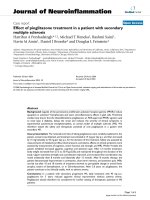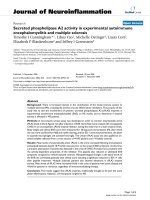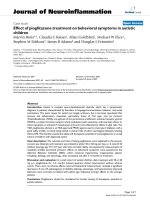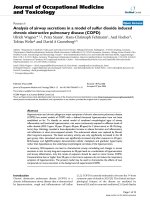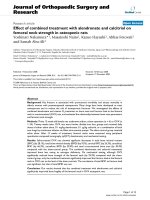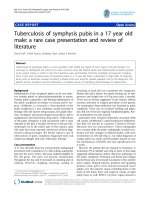báo cáo hóa học: " Effect of pioglitazone treatment in a patient with secondary multiple sclerosis" doc
Bạn đang xem bản rút gọn của tài liệu. Xem và tải ngay bản đầy đủ của tài liệu tại đây (593.33 KB, 4 trang )
BioMed Central
Page 1 of 4
(page number not for citation purposes)
Journal of Neuroinflammation
Open Access
Case report
Effect of pioglitazone treatment in a patient with secondary
multiple sclerosis
Harrihar A Pershadsingh*
1,2
, Michael T Heneka
2
, Rashmi Saini
1
,
Navin M Amin
1
, Daniel J Broeske
3
and Douglas L Feinstein
4
Address:
1
Departments of Family Medicine, Kern Medical Center, Bakersfield, and University of California, Irvine, California, USA,
2
Department
of Neurology, University of Bonn, Bonn, Germany,
3
Department of Internal Medicine, Kern Medical Center, Bakersfield, California, USA and
4
Department of Anesthesiology, University of Illinois, Chicago, Illinois, USA
Email: Harrihar A Pershadsingh* - ; Michael T Heneka - ;
Rashmi Saini - ; Navin M Amin - ; Daniel J Broeske - ;
Douglas L Feinstein -
* Corresponding author
Multiple sclerosisthiazolidinedionePPARγpioglitazoneinflammation
Abstract
Background: Ligands of the peroxisome proliferator-activated receptor-gamma (PPARγ) induce
apoptosis in activated T-lymphocytes and exert anti-inflammatory effects in glial cells. Preclinical
studies have shown that the thiazolidinedione pioglitazone, an FDA-approved PPARγ agonist used
to treat type 2 diabetes, delays the onset and reduces the severity of clinical symptoms in
experimental autoimmune encephalomyelitis, an animal model of multiple sclerosis (MS). We
therefore tested the safety and therapeutic potential of oral pioglitazone in a patient with
secondary MS.
Case presentation: The rationale and risks of taking pioglitazone were carefully explained to the
patient, consent was obtained, and treatment was initiated at 15 mg per day p.o. and then increased
by 15 mg biweekly to 45 mg per day p.o. for the duration of the treatment. Safety was assessed by
measurements of metabolic profiles, blood pressure, and edema; effects on clinical symptoms were
assessed by measurement of cognition, motor function and strength, and MRI. Within 4 weeks the
patient exhibited increased appetite, cognition and attention span. After 12 months treatment,
body weight increased from 27.3 to 35.9 kg (32%) and maintained throughout the duration of the
study. Upper extremity strength and coordination improved, and increased fine coordination was
noted unilaterally after 8 months and bilaterally after 15 months. After 8 months therapy, the
patient demonstrated improvement in orientation, short-term memory, and attention span. MRIs
carried out after 10 and 18 months of treatment showed no perceptible change in overall brain
atrophy, extent of demyelination, or in Gd-enhancement. After 3.0 years on pioglitazone, the
patient continues to be clinically stable, with no adverse events.
Conclusions: In a patient with secondary progressive MS, daily treatment with 45 mg p.o.
pioglitazone for 3 years induced apparent clinical improvement without adverse events.
Pioglitazone should therefore be considered for further testing of therapeutic potential in MS
patients.
Published: 20 April 2004
Journal of Neuroinflammation 2004, 1:3
Received: 24 March 2004
Accepted: 20 April 2004
This article is available from: />© 2004 Pershadsingh et al; licensee BioMed Central Ltd. This is an Open Access article: verbatim copying and redistribution of this article are permitted in
all media for any purpose, provided this notice is preserved along with the article's original URL.
Journal of Neuroinflammation 2004, 1 />Page 2 of 4
(page number not for citation purposes)
Background
Current therapies for MS are limited in efficacy and can
have adverse effects. Although immuno-modulating type-
1β interferons and glatiramer acetate reduce active CNS
inflammatory lesions, clinical severity and attack fre-
quency in relapsing remitting MS, they are less efficacious
in progressive disease [1]. The immunosuppressive agent,
mitoxantrone is presently approved for treating progres-
sive MS but is limited because of severe adverse side-
effects especially cardiotoxicity [1]. The insulin-sensitizing
anti-diabetic thiazolidinediones (TZDs) are high affinity
activators of the nuclear transcription factor peroxisome
proliferator-activated receptor-gamma (PPARγ). TZDs
inhibit T lymphocyte proliferation and activation, reduce
expression and production of inflammatory molecules
including interleukin-1β, tumor necrosis factor-α and
inducible nitric oxide synthase, increase astrocyte metab-
olism and resistance to cytotoxicity [11], and reduce clin-
ical symptoms in experimental autoimmune
encephalomyelitis (EAE), an autoimmune-mediated,
demyelinating disease which provides a model for MS
[2,3]. In view of these effects and the established safety
profile of TZDs, we investigated the therapeutic potential
of the FDA-approved anti-diabetic TZD pioglitazone in a
patient with secondary progressive MS.
Case presentation
A 44-year-old woman with secondary progressive MS was
diagnosed at age 20 yr, per Lublin and Reingold [4]. Dur-
ing the next 15 years she had 8 documented relapses
which resolved with intravenous glucocorticoid therapy.
The relapses decreased in frequency during this time, after
which her clinical status deteriorated, with progressive
development of quadriparesis, ataxia, fatigue and cogni-
tive decline. In 1994, a trial of interferon β-1b was discon-
tinued because of increased spasticity, and she was not a
candidate for glatiramer. She had no history of diabetes,
cardiovascular, liver or kidney disease.
When seen in 1999 her weight was 29.5 kg, down from
54.5 kg in 1976. She was paraplegic, wheelchair-bound,
and exhibited paresis of the upper extremities with OMS
(Oxford Muscle Strength) score of 2–3 out of 5 (Table 1)
and an EDSS score of 8.0. Neurological presentation
included paraplegia, bilateral central scotomata with vis-
ual-field loss, dysphagia, chronic fatigue, cognitive
impairment similar to mild dementia, and depressed
mood. In June 2000, having explained the rationale and
risks, she consented to a trial of pioglitazone, which was
initiated at 15 mg daily and increased by 15 mg biweekly
to 45 mg. Improvement was evident within 4 weeks as
increased appetite, cognition and attention span. Her
weight increased from 27.3 to 35.9 kg (32%) after 12
months treatment, which was maintained between 34.6
to 36.2 kg throughout an additional 18 months. Weight
gain was evident as increased muscle mass and peripheral
fat, mainly in the hips, gluteal area, and limbs. Upper
extremity strength and coordination progressively
improved (Table 1). Improved fine coordination was
noted unilaterally after 8 months (left finger-to-nose exe-
cution), and bilaterally after 15 months. Before pioglita-
zone, repetitive statements and forgetfulness, reminiscent
of dementia, were problematic. After 8 months therapy,
cognitive assessment demonstrated improvement in ori-
entation, short-term memory (recall increased from 0/3 to
2/3 objects), attention span, registration and insight, and
is consistent with clinical improvement [5]. According to
DSM IV criteria, her depression also improved signifi-
cantly, along with the progressive gain in weight and
improvement in neurological function as a whole. She
was progressively able to tolerate outdoor social activities
for several hours at a time, with improved stamina and
well-being.
Table 1: Upper Extremity Muscle Strength Before and After 52 Weeks on Pioglitazone
Muscle Strength Grade
Muscle Group/Function Before PIO (Baseline) 15 months After PIO 30 months After PIO
Right Left Right Left Right Left
Hand Flexor Group/Grip234545
Bicep/Arm Flexion 234545
Tricep/Arm Extension124545
Shoulder Flexion 1 2 4 5 4 5
Shoulder Abduction 2 3 4 5 4 5
Muscle strength determined using the Oxford Muscle Strength Grading Scale (Grade 0 = No movement; Grade 3 = Completely moves body part
against gravity; Grade 5 = Normal)
Journal of Neuroinflammation 2004, 1 />Page 3 of 4
(page number not for citation purposes)
During the study, two MRI studies with gadolinium (Gd)
were performed, one 18 months after initiation of piogli-
tazone and the second 10 months later (Figure 1). There
was no perceptible change in overall brain atrophy, extent
of demyelination, or in Gd-enhancement indicating that
at least over the 10 months between the MRI studies, the
disease was quiescent. This also suggests that the benefi-
cial effects of pioglitazone treatment were not associated
with any overt improvement in pathology. After 3 years
on pioglitazone, she continues to be clinically stable.
There have been no adverse events, and her metabolic
profile has remained normal throughout the study.
Conclusions
The limited efficacy and safety of immuno-modulatory
and immuno-suppressive agents available for treating
progressive MS warrants development of improved and
safer therapies [1]. MS is an autoimmune disease associ-
ated with inappropriate T lymphocyte activation, CNS
inflammation and demyelination, resulting in axonal and
neuronal damage [1]. The thiazolidinedione class of drugs
were developed for the treatment of type 2 diabetes and
act by improving insulin resistance without causing
hypoglycemia, even in euglycemic individuals. They were
later found to activate PPARγ and shown to promote anti-
inflammatory and immunosuppressive effects by sup-
pressing T lymphocyte activation, proliferation, and
inhibiting cellular production of inflammatory molecules
associated with MS [3,6,7].
The beneficial effects of pioglitazone observed in this
patient are somewhat unexpected as inflammation is less
Axial T1-weighted fluid-attenuated inversion recovery (FLAIR) MRI images showing confluent demyelinationFigure 1
Axial T1-weighted fluid-attenuated inversion recovery (FLAIR) MRI images showing confluent demyelination. MRIs were taken
at 10 months (left) and at 18 months (right) after initiation of treatment with pioglitazone. Similar axial sections are shown for
the two time points.
10 months 18 months
Publish with BioMed Central and every
scientist can read your work free of charge
"BioMed Central will be the most significant development for
disseminating the results of biomedical research in our lifetime."
Sir Paul Nurse, Cancer Research UK
Your research papers will be:
available free of charge to the entire biomedical community
peer reviewed and published immediately upon acceptance
cited in PubMed and archived on PubMed Central
yours — you keep the copyright
Submit your manuscript here:
/>BioMedcentral
Journal of Neuroinflammation 2004, 1 />Page 4 of 4
(page number not for citation purposes)
prominent in secondary progressive MS compared to
relapsing remitting disease. However, improvements in
upper body strength, coordination, dysphagia, and cogni-
tive function, suggest neurological benefit associated with
pioglitazone treatment. In addition to their anti-inflam-
matory actions, TZDs can also influence cell physiology in
a receptor-independent manner, and we recently demon-
strated that TZDs increase astrocyte glucose metabolism
and lactate production [11]. It is therefore feasible that
effects on brain metabolism, for example increased capac-
ity of astrocytes to provide lactate to surrounding neurons,
accounts in part for improved cognitive and motor func-
tion. However, the persistence of lower extremity paralysis
appears a likely consequence of irreversible spinal cord
atrophy. The 30% gain in weight markedly exceeds the
approximately 2–4% weight gain seen with diabetics [see
prescribing information: ACTOS
®
(pioglitazone hydro-
chloride), Takeda Chemical Co.]. While this may reflect
decreased depression, there are as yet no reports that
pioglitazone or any other thiazolidinedione, influence
mood disorders.
In EAE mice pioglitazone decreased disease incidence,
reduced maximum disease severity, and induced remis-
sion in already-ill animals [3]. Similar results were
obtained with other TZDs including rosiglitazone,
another approved antidiabetic drug [3]. These drugs have
also been shown to clinically ameliorate other inflamma-
tory diseases [8] including psoriasis [9] and ulcerative col-
itis [10]. Described adverse effects for pioglitazone are
confined to the diabetic population, and include mild
edema, and limited weight gain, and pioglitazone has not
been causally linked to hepatic failure, as has troglitazone.
These findings imply that pioglitazone, and perhaps other
insulin-sensitizing TZDs may provide therapeutic benefit
in MS.
Abbreviations
DSM, diagnostic and statistical manual of mental disor-
ders; FLAIR, fluid attenuation inversion recovery; Gd,
gadolinium; MRI, magnetic resonance imaging; MS, mul-
tiple sclerosis; PIO, pioglitazone; PPARγ, peroxisome
proliferator-activated receptor gamma; TZD,
thiazolidinedione.
Competing interests
None declared.
Authors' contributions
HAP was the primary physician, conceived of the original
study, and prepared first draft of the manuscript. MTH
was a consulting neurologist, evaluated MRI data, assisted
with manuscript editing, and contributed to the original
idea of treating MS patients with TZDs. RS performed clin-
ical assessments. NM and DJB consulted on clinical eval-
uations and response to therapy. DLF organized and
analyzed data, contributed to the original idea to treat MS
patients with TZDs, helped write and edit, and wrote the
final draft of the manuscript.
Acknowledgements
We thank Monica Menendez for secretarial assistance. Supported by grants
from the National Multiple Sclerosis Society (DLF), Takeda Pharmaceuticals
(DLF) and Bethesda Pharmaceuticals, Inc (HAP). Written consent was
obtained from the patient for publication of study.
References
1. Keegan BM, Noseworthy JH: Multiple sclerosis. Annu Rev Med
2002, 53:285-302.
2. Niino M, Iwabuchi K, Kikuchi S, et al.: Amelioration of experimen-
tal autoimmune encephalomyelitis in C57BL/6 mice by an
agonist of peroxisome proliferator-activated receptor-
gamma. J Neuroimmunol 2001, 116:40-48.
3. Feinstein DL, Galea E, Gavrilyuk V, et al.: Prevention and treat-
ment of experimental autoimmune encephalomyelitis by
pioglitazone, a PPAR-γ agonist. Ann Neurol 2002, 51:694-702.
4. Lublin FD, Reingold SC: Defining the clinical course of multiple
sclerosis: results of an international survey. National Multi-
ple Sclerosis Society (USA) Advisory Committee on Clinical
Trials of New Agents in Multiple Sclerosis. Neurology 1996,
46:907-911.
5. DeSousa EA, Albert RH, Kalman B: Cognitive impairments in
multiple sclerosis: a review. Am J Alzheimers Dis Other Demen
2002, 17:23-9.
6. Debril MB, Renaud JP, Fajas L, Auwerx J: The pleiotropic functions
of peroxisome proliferator-activated receptor-γ. J Mol Med
2001, 79:30-47.
7. Clark RB: The role of PPARs in inflammation and immunity. J
Leukoc Biol 2002, 71:388-400.
8. Pershadsingh HA: PPAR-gamma-Therapeutic target for dis-
eases beyond diabetes: 2uo vadis? Expert Opin Investig Drugs 2004,
13:212-215.
9. Ellis CN, Varani J, Fisher GJ, et al.: Troglitazone improves psoria-
sis and normalizes models of proliferative skin disease: lig-
ands for peroxisome proliferator-activated receptor-gamma
inhibit keratinocyte proliferation. Arch Dermatol 2000,
136:609-16.
10. Lewis JD, Lichtenstein GR, Stein RB, et al.: An open-label trial of
the PPAR-gamma ligand rosiglitazone for active ulcerative
colitis. Am J Gastroenterol 2001, 96:3323-8.
11. Dello Russo C, Galea E, Gavrilyuk V, Weinberg G, Palmer J, Almeida
A, Bolanos JP, Pelligrino D, Feinstein DL: PPARγ agonists increase
glucose metabolism in astrocytes. J Biol Chem 2003,
278:5828-36.


